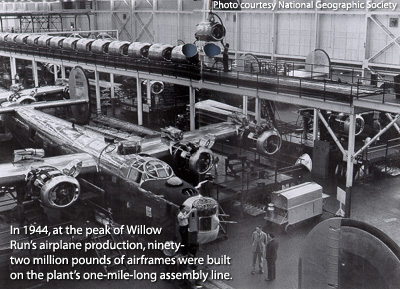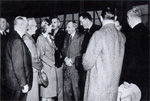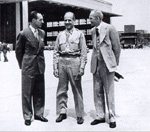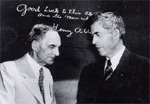|

By David L.
Lewis
Wartime
requires homefront heroes, as well as battlefield heroes. The American
War for Independence produced Robert Morris, the "financier of the
Revolution," the man who supplied Washington’s army. The Civil
War produced Jay Cooke, the super-bond salesman who helped finance the
Union cause. World War I homefront heroes included Charles Schwab,
Bernard Baruch, Thomas Edison and Henry Ford.
The December
1941 Japanese attack on Pearl Harbor prompted an all-out effort to boost
industrial production as quickly as possible. General Motors, Curtiss-Wright,
Ford, Kaiser, DuPont and Chrysler, among others, quickly established
themselves as leading defense contractors. Each company’s efforts were
publicized to one degree or another, but none received more recognition
than Henry Ford, who became one of the nation’s prime symbols of
wartime production heroics.
 Henry Ford
not only personified his company—he was the company for four
decades prior to World War II. During the war the company finally
superseded the man in importance. Even so, the wartime focus remained on
the man, not the company. Henry Ford
not only personified his company—he was the company for four
decades prior to World War II. During the war the company finally
superseded the man in importance. Even so, the wartime focus remained on
the man, not the company.
Until August
1942 virtually all of the publicity about Henry Ford and his company was
extremely favorable. The press glowed with accounts of Ford’s World
War I record, his transformation from a pre-World War II pacifist to a
war producer, and his real and alleged foresight in gearing his company
for military production before America’s entry into the war.
But if the
press applauded Ford’s earlier stance on military production, it
almost ran out of superlatives in discussing his contribution to the
World War II defense effort. From early 1942, despite all else that Ford
was doing, nearly all of this discussion centered around Ford’s Willow
Run bomber plant, which in the minds of many Americans symbolized both
the Ford war effort and America’s intent to fill the skies with heavy
bombers.
Several
factors contributed to the dramatization of Willow Run. At a time when
aircraft industrial leaders were highly skeptical of plans to
mass-produce airplanes, the plant embodied a daring attempt—the first—to
produce aircraft on a full-blown assembly-line system. Moreover, Willow
Run was operated by America’s premier manufacturer—the man popularly
credited with having invented mass production and universally regarded
as its foremost exponent. Many people took it for granted that Ford’s
newest plant, like his renowned Highland Park and River Rouge factories,
would blaze new methods of manufacturing and set new production records.
Willow Run
also impressed everyone by its size. The main building was
3,200-by-1,180 feet, with more than 2.5 million square feet of floor
space—more floor area than the prewar airplane manufacturing factories
of Consolidated Aircraft Corporation, Douglas Aircraft Company and
Boeing Aircraft Company combined. "There seems to be no end to
anything," enthused one journalist. "Like infinity, it
stretches everywhere into the distance of man’s vision."
Completed in
1941, the plant was the largest factory in the world under a single
roof, and remained so until the 1943 completion of Chrysler’s mammoth,
but less publicized, Chicago aircraft engine plant. (The Chrysler plant
was less publicized for two reasons. It produced an engine, rather than
a plane. Also, the plant, along with its parent Chrysler Corporation,
was managed by unknowns; Walter P. Chrysler died in 1940.)
Apart from
its size, Willow Run was assigned one of the war’s glamour products—the
four-engine, long-range B-24 bomber, one of the biggest, fastest and
most destructive aircraft in the world. Amid the gloom of 1942, the
United States looked with hope to the B-24 (labeled the Liberator by the
British) and its companion bomber, the B-17. "These planes,"
declared Fortune magazine in April 1942, "represent our
supreme bid to regain the initiative. They may save our honor, our hopes—and
our necks."
Willow Run,
located near Ypsilanti, about thirty miles west of Detroit, began
limited parts production in November 1941. By the time the United States
entered the war, however, no part of the factory was complete. The main
building and the flying field were not completed until early 1942. But
the plant, except for the relatively small area where parts production
was underway, was in a state of turmoil as tools were received, fixtures
set up and supervisors and untrained employees tried coping with an
alien undertaking. The task was aggravated by a severe housing shortage
near the Willow Run vicinity and the length of time required—an hour
or more each way—for Detroit workers to commute to and from their
jobs.
Willow Run’s problems
were ignored or glossed over in the hundreds of newsstories and
editorials about the huge plant in early 1942. Instead, the press dwelt
on the size of the factory and the scope of its operations, referring to
it as the "most enormous room in the history of man," the
"largest building in the history of the world" and the
"mightiest wartime effort ever made by industry." The plant
was described as a "marvelous factory" by the Boston
American, an "amazing bomber plant" by the New York Sun;
a "U.S. miracle" by the nineteen newspapers of the
Scripps-Howard chain and by other publications as "Henry Ford’s
miracle," "one of the seven wonders of the world,"
"the greatest show on earth" and as the "damndest
colossus the industrial world has ever known." Dozens of newspapers
declared that Willow Run spelled ruin for the Axis countries. "It
is a promise of revenge for Pearl Harbor," said a Detroit paper.
"You know when you see Willow Run that in the end we will give it
to the Japanese good."
If praise of the plant
itself indicated that Ford had wrought yet another miracle, statements
and forecasts about how soon and how many bomber would flow from the
facility confirmed this impression a hundredfold. Most press reports
stated that B-24s would roll off the assembly line "before June
1." A radio broadcast beamed to Manila Bay, Philippines, in
February 1942, reported that Ford was already producing
"astronomical" numbers of planes for the U.S. Army Air Corps.
The broadcast spurred embattled American and Filipino troops on the
Bataan Peninsula and Corregidor Island to start a "Bomber for
Bataan" fund; some servicemen pledged a month’s pay to the futile
enterprise.
Many of the stories about
Willow Run reported that the plant, once production began, would build
bombers at the "unprecedented" and "unbelievable"
rate of "one every two hours," "one per hour,"
"two per hour," "dozens daily," "en masse"
and "one every few minutes," just like cars. (Compare these
figures to the 169 B-24s built in 1941 by the plane’s designer.
Consolidated Aircraft.) Several publications even reported that 1,000
B-24s would emerge from the factory every twenty-four hours. The most
exaggerated estimate of the plant’s future production appeared in the
usually conservative New York Herald Tribune, which
boasted, "Willow Run annually will produce planes by the tens of
thousands and eventually, if required, by the hundreds of
thousands."
These statements were
premature and highly inaccurate. Willow Run did not produce a plane
until July 1942, and that one was a knockdown sent to a Douglas Aircraft
assembly plant in Tulsa, Oklahoma. The first flyaway was not turned over
to the United States Army until September 10, 1942.
The Ford Motor Company
should have refuted the statements or at least cautioned against
overoptimism. It did neither, and the paeans of praise continued
unabated. Some of the plaudits were initiated by starry-eyed visitors to
the plant. The president of Peru told reporters, "This plant is
wonderful . . . It will bring quick victory." Captain Randolph
Churchill, son of the British prime minister, assured the press that
"if Adolf Hitler could see Willow Run, he’d cut his throat right
now." Sir Oliver Lyttleton, Britain’s minister of production,
noted that if Hitler and Goering visited Will Run they "Would have
thrown in their hands, or blown out their brains." He concluded,
"Five men with the imagination of Henry Ford would end this war
within a period of six months."
The myth that Willow Run
was performing production miracles exploded in August 1942 when James H.
"Dutch" Kindelberger, the blunt president of North American
Aviation, told a startled group of reporters that Willow Run, despite
all of the talk, had yet to manufacture an airplane.
Kindelberger’s statement
was quickly picked up and expanded on "The March of Time," a Time
magazine-sponsored national radio newscast, and in Time’s
sister publication, Life. Although pressed to deny or confirm the
charges made by Kindelberger, inexplicably neither the Ford company nor
the War Department offered immediate comment. The press, led to believe
that Willow Run was building complete bombers (at the rate of one per
hour, according to some reports), was baffled.
The press remained
perplexed and was barred from the plant until November. By then planes
were being built, both knockdowns and flyaways, and net production
totaled fifty-six. Meanwhile, in September President Franklin Roosevelt
and his wife, Eleanor, secretly toured Willow Run. Following the visit
the Office of Censorship issued conflicting reports on whether or not
the president had seen bombers in production.
In January 1943 the
government’s War Production Board officially criticized Willow Run’s
performance for the first time. The factory’s primary problem,
according to the board, was a shortage of manpower, the plant found it
difficult to hire and keep competent workers.
The board’s report
unleashed a barrage of criticism, leading many people across the country
to call the plant "Willit Run?"—a name allegedly coined by
rival aircraft manufacturers. This criticism prompted Senator Harry
Truman, chairman of the Senate Committee Investigating the National
Defense Program, to conduct an immediate inquiry into Willow Run
production. "There has been so little production," snapped
Truman, "as to amount to virtually none."
Criticism notwithstanding,
Willow Run’s production was mounting—31 planes in January 1943, 75
in February, 148 in April and 190 in June. The press was congratulatory.
"At long last," declared Business Week, "America
is finding its faith in Henry Ford and Willow Run reestablished. And
this time it rests on the solid fact of bomber production." In
April Charles E. Wilson, vice-chairman of the War Production Board, told
reporters after touring Willow Run that the plant was "on the beam
. . . The Willow Run plant will be turning out 500 planes a month by the
time the next snow flies." Unfortunately, the day after Wilson’s
visit snow fell in Detroit.
On July 10 the Truman
committee issued its long-awaited findings on Willow Run. The report
acknowledged that "some delay had to be expected" in building
a large number of "huge and complicated" airplanes such as the
B-24. But it also was critical of Willow Run’s performance, which
fueled rumblings of dissatisfaction; in September the Army Material
Command suggested the government unseat Henry Ford and take over the
management of the factory.
During the last few months
of 1943, as the giant plant began living up to its press notices of 1941
and the first half of 1942, the threat of a government takeover faded.
Bomber production, which stood at 190 in June 1943, increased to 231 in
August, 308 in October and 365 in December. In October a War Production
Board report on the aircraft industry revealed that "whereas Willow
Run was one of the poorest producers last Fall it is now one of the
best." The report added that "production per man at Willow Run
has risen about 40 times in the last year."
As the plant entered a
period of glory in 1944 its production reports were impressive. In March
Willow Run produced its three thousandth bomber. On April 16 Ford
announced that Willow Run, starting that previous February, had achieved
its long-sought goal—the production of "approximately one bomber
an hour." By July 1 Willow Run had built five thousand bombers,
half of them in the first six months of 1944. At the same time, it was
reported that "the automotive type precision tooling at Willow Run
had resulted in such uniformity of production that more than half of all
of the Ford-built Liberators were accepted for delivery on their maiden
flights," an unusually high percentage of plane approval.
As many of the early
production boasts of Ford spokesmen and the press began coming true, the
plant and company officials were lauded to the skies. In April 1944
Senator Truman, after visiting the bomber plant, called Henry Ford
"the production genius" of the United States. In mid-April,
following the announcement of the bomber-per-hour production rate,
dozens of newspapers hailed Willow Run as "the war production
miracle that has been wrought in Detroit" and as the plant that
furnished "a sky-full of bombers to wreck the Nazi war
machine." Henry Ford was accorded similar praise. "His
achievement is tremendous," declared the Asheville (North
Carolina) Citizen in a representative editorial. "He
symbolizes the remarkable industrial techniques which have made this
nation one vast armory."
During the remainder of
1944 and through 1945 hundreds of stories on Willow Run appeared in
newspapers and magazines. Many of the phrases used to describe the plant
were as effusive as, and reminiscent of, those published during the
first half of 1942—"a symbol of American ingenuity," a
"magnificently-tooled colossus," a "product of inventive
genius," "one of the world’s great monuments of production
genius," a "production miracle" and the "miracle
production story of the war."
In 1944, Willow Run’s
peak production year, the plant built 92 million pounds of airframes,
far more poundage than had ever poured out of any one plant in one year
and 4.6 percent of all U.S. airframe production during the years
1940-44. Willow Run ’s 1944 airframe production almost equaled Japan’s
total airframe poundage for that year—and was approximately half that
of either Germany, Great Britain or the Soviet Union. Moreover, the
factory’s assembly-line production methods permitted Ford to deliver
Liberators to the government for $137,000 each in 1944, compared to
$238,000 two years earlier.
The plant’s highest
monthly bomber output, 428, was attained in August 1944. After
September, when the plant was geared to make 650 bombers a month (or
9,000 planes per year) it did not produce to its fullest capacity (the
War Department having ordered cutbacks on B-24 production in favor of
building the larger B-29 and B-32 bombers at other factories).
The total number of B-24s
built at Willow Run was 8,685. The last bomber, named the "Henry
Ford," moved off the assembly line on June 24, 1945. A few minutes
before the plane was to be towed from the plant, Henry Ford requested
that his name be removed from the nose of the ship and that employees
sign their names in its place.
Although Ford contributed
far less to the overall war effort than General Motors (GM), the public
believed that he had done more to win the war than GM or any other
automobile company. A national sample of public opinion by Elmo Roper in
July 1944 showed that 31 percent of the American people believed that
Ford was contributing more to the war effort than any other automaker,
as opposed to 21 percent for GM. In the spring of 1945 Roper found that
Henry Ford ranked second only to Henry J. Kaiser, a major West Coast
shipbuilder, as the man to have done more to win the war than any other
American, not counting Presidents Roosevelt and Truman and military
figures Ford received approximately twice as many votes as the men
ranked third and fourth in the pool. Donald M. Nelson, chairman of the
War Production Board, and James F. Byrnes, director of war mobilization.
In reality, Henry Ford’s
contribution to his company’s war effort was limited, and later was
said to be nil by Ford’s top manufacturing executive, Charles
Sorensen. Sorensen’s view, according to Sorensen, was shared during
the war by highly-placed Washington officials including Charles E.
Wilson and President Roosevelt.
Ford undoubtedly gave more
attention to Willow Run than any other of his wartime plants. But his
contribution to Willow Run’s success is debatable. Edsel Ford said in
1943 that his father "put a lot of his ideas" into the
project. Conversely, Sorensen countered that the octogenarian was simply
"the glorified leader" and "had nothing to do with the
program." He would, said Sorensen, "have a look at how things
were going on at Willow Run, but talk about its problems went in one ear
and out the other."
What is certain is that
Ford approved the idea of building the plant, passed on major policy
decisions affecting it and had a keen interest in its construction and
efforts to move it into production. He was a frequent, almost daily,
visitor to the factory during the first two years of the war. Numerous
photographs show him inspecting assembly lines and crawling under and
around B-24s. He also fretted incessantly over the delays in bomber
production.
The statement by the head
of a California aircraft plant that "Ford would drop $100 million
to get his bombers out" probably was a correct assessment of the
magnate’s attitude toward the B-24 program. Ford’s pride was hurt
when the press referred to his plant as "Willit Run?"; he was
vastly pleased when in late 1943 the factory refuted its critics. In
Willow Run’s banner year, 1944, when Ford’s physical and mental
health perceptibly deteriorated, he was seen less frequently at the
plant. The following year his precarious health prevented him from
attending the ceremony marking the end of bomber production. All factors
considered, Sorensen’s evaluation of Ford’s contribution to the
bomber effort seems harsh but not unjust. Willow Run was a miracle
plant, but Henry Ford was not a miracle man, and the wartime belief that
he was is one of the great myths of World War II.
Neither the Ford Motor
Company, nor any other person or company won the homefront war
single-handedly A massive team effort was required, and perhaps the
greatest heroes of all, at least in the aggregate, were the millions of
workers who toiled in defense plants across the nation.
World War II, as we look
back on it, seems somewhat larger than life. It was a time of heroes,
miracles and myths, both on the battlefield and on the home front. Both
America’s productive capacity and its people were tested as never
before—or since. Every important test was met by companies like Ford
and by millions of ordinary people who produced the materials of war and
filled homefront needs.
Today, most Americans look
back with satisfaction and pride, perhaps even with some nostalgia, on
World War II’s great homefront achievements. That is because no other
county, friend or foe, came close to matching the homefront heroics—and
miracles—of America in the "Big One."
This article first
appeared in the September/October 1993 issue of Michigan History.
|
Touring
Willow Run
Once production began at Willow Run, visitors flocked to tour
what one newspaper called "the damndest colossus the
industrial world has ever known." Unabashedly proud of
Willow Run, Henry Ford often hosted celebrities including politicians,
generals and movie stars.
Photos The Henry Ford |

President Franklin D. Roosevelt (far left) September 18, 1942 |

Representative Clare Booth Luce and other members of the
House Military Affairs Committee November 1943 |

General James Doolittle (center) and Ford's son, Edsel
May 29, 1942 |

Eddie Rickenbacker (far left) January 22, 1943 |

French General Henri Giraud
July 15, 1943 |

Vice-president Henry A. Wallace
July 24, 1943 |

U.S. Treasury Secretary Henry Morgenthau, Jr. (left) and Ford
Motor Company production chief Charles Sorensen (center) 1943 |
|